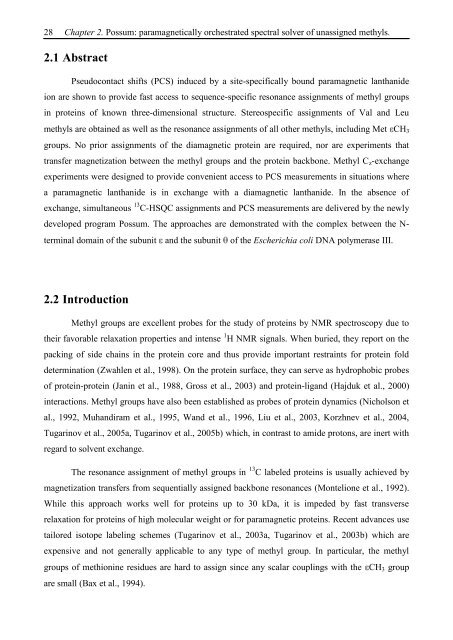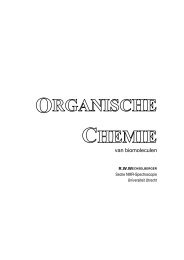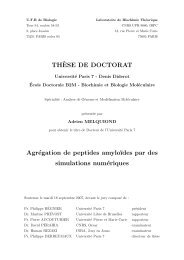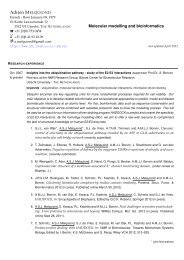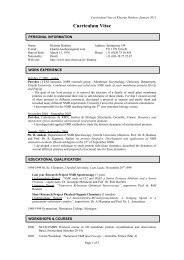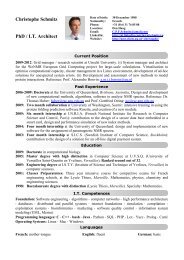Thesis Title: Subtitle - NMR Spectroscopy Research Group
Thesis Title: Subtitle - NMR Spectroscopy Research Group
Thesis Title: Subtitle - NMR Spectroscopy Research Group
Create successful ePaper yourself
Turn your PDF publications into a flip-book with our unique Google optimized e-Paper software.
28 Chapter 2. Possum: paramagnetically orchestrated spectral solver of unassigned methyls.<br />
2.1 Abstract<br />
Pseudocontact shifts (PCS) induced by a site-specifically bound paramagnetic lanthanide<br />
ion are shown to provide fast access to sequence-specific resonance assignments of methyl groups<br />
in proteins of known three-dimensional structure. Stereospecific assignments of Val and Leu<br />
methyls are obtained as well as the resonance assignments of all other methyls, including Met CH3<br />
groups. No prior assignments of the diamagnetic protein are required, nor are experiments that<br />
transfer magnetization between the methyl groups and the protein backbone. Methyl Cz-exchange<br />
experiments were designed to provide convenient access to PCS measurements in situations where<br />
a paramagnetic lanthanide is in exchange with a diamagnetic lanthanide. In the absence of<br />
exchange, simultaneous 13 C-HSQC assignments and PCS measurements are delivered by the newly<br />
developed program Possum. The approaches are demonstrated with the complex between the N-<br />
terminal domain of the subunit and the subunit of the Escherichia coli DNA polymerase III.<br />
2.2 Introduction<br />
Methyl groups are excellent probes for the study of proteins by <strong>NMR</strong> spectroscopy due to<br />
their favorable relaxation properties and intense 1 H <strong>NMR</strong> signals. When buried, they report on the<br />
packing of side chains in the protein core and thus provide important restraints for protein fold<br />
determination (Zwahlen et al., 1998). On the protein surface, they can serve as hydrophobic probes<br />
of protein-protein (Janin et al., 1988, Gross et al., 2003) and protein-ligand (Hajduk et al., 2000)<br />
interactions. Methyl groups have also been established as probes of protein dynamics (Nicholson et<br />
al., 1992, Muhandiram et al., 1995, Wand et al., 1996, Liu et al., 2003, Korzhnev et al., 2004,<br />
Tugarinov et al., 2005a, Tugarinov et al., 2005b) which, in contrast to amide protons, are inert with<br />
regard to solvent exchange.<br />
The resonance assignment of methyl groups in 13 C labeled proteins is usually achieved by<br />
magnetization transfers from sequentially assigned backbone resonances (Montelione et al., 1992).<br />
While this approach works well for proteins up to 30 kDa, it is impeded by fast transverse<br />
relaxation for proteins of high molecular weight or for paramagnetic proteins. Recent advances use<br />
tailored isotope labeling schemes (Tugarinov et al., 2003a, Tugarinov et al., 2003b) which are<br />
expensive and not generally applicable to any type of methyl group. In particular, the methyl<br />
groups of methionine residues are hard to assign since any scalar couplings with the CH3 group<br />
are small (Bax et al., 1994).


